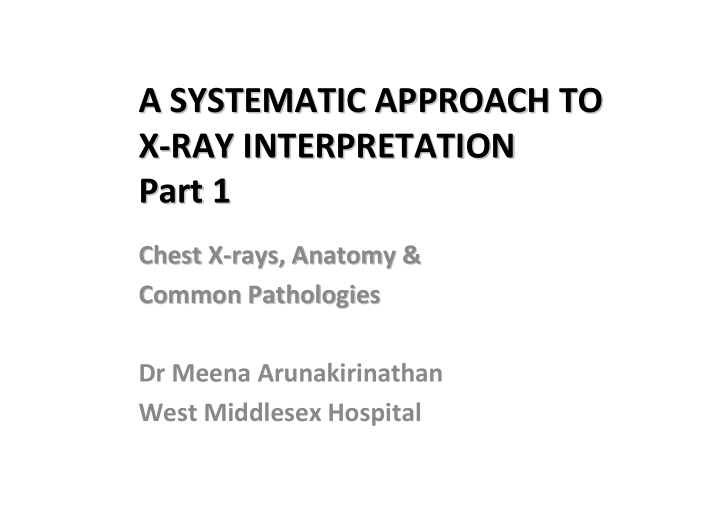



A SYSTEMATIC APPROACH TO A SYSTEMATIC APPROACH TO X- -RAY INTERPRETATION RAY INTERPRETATION X Part 1 Part 1 Chest X- -rays, Anatomy & rays, Anatomy & Chest X Common Pathologies Common Pathologies Dr Meena Arunakirinathan West Middlesex Hospital
Objectives • To review the anatomy relevant to chest x- rays. • To learn a systematic approach to x-ray interpretation. • To apply this approach to interpreting chest x- rays. • To identify some common pathologies detectable by chest x-ray.
5 main densities are seen on XR… • Black = gas • White = calcified structures • Grey = soft tissues • Slightly darker grey = fat, i.e. it absorbs slightly fewer x-rays • Intense, bright white = metallic objects
Take 10 seconds to examine this film…
A SYSTEMATIC APPROACH TO X-RAY INTERPRETATION 1. The right film for the right person 2. Using the “A, B, C, S” system to ensure that the following principles are covered: a) Technical details b) Interventions c) Systematic search for pathology d) Abnormal opacities
The right film for the right person • Is this the right patient: – Name – DOB – Hospital number • Is this the right film? – Date of x-ray – Time of x-ray
“A” is for adequacy, alignment and apparatus Upper thoracic spine are discernible ECG leads Equal distance between vertebral spines and medial ends of clavicles Gastric air bubble under left hemidiaphragm This erect chest x-ray film is adequately penetrated and is not rotated.
“B” is for bones Multiple rib fracture - look for evidence of great vessel injury and anticipate organ injury Close-up of PA CXR show lytic lesion within right acromion Mass-like opacity over 9 th right rib
“C” is for cartilage & joints • Do the anterior ribs appear to extend to the sternum? – Calcification of rib cartilages • Examine all joints for degenerative joint disease – Joint space narrowing – Osteophytes = bone spurs – Osteopaenia = demineralisation of bone – Marginal erosions where bone meet synovium – Subluxation
“S” is for soft tissue In the assessment of soft tissues, start centrally, proceeding to surrounding areas, and then peripherally… • Central – mediastinum • Surrounding areas – neck, lungs, diaphragm, breast shadow • Peripheral – subcutaneous tissue
“S” is for soft tissues – mediastinum
“S” is for soft tissue – surrounding areas
A close-up of right shoulder demonstrating streaking lucency : subcutaneous emphysema overlying the shoulder and upper chest with muscle bundles of pectoralis becoming visible
4 causes of “white out” Consolidation Pleural effusion Complete lung collapse Pneumectomy
Coming back to this slide…
Systematically interpret this chest x-ray
CLINICAL SCENARIOS
A 56 year-old man who is HIV positive presented to the A&E with a 2-week history of pleuritic, right-sided chest pain, fever, rust coloured sputum and dyspnoea. Chest auscultation revealed bronchial breathing and inspiratory crackles over the right, middle lobe, along with dullness on percussion. What are the differential diagnoses? How could this condition be managed?
• There is opacity in the right middle lung. • This is consolidation in the right middle lung indicative of pneumonia . • In this image the left heart border is intact, but watch for loss of diaphragmatic silhouettes and blunting of the costodiaphragmatic angle which would occur in lower lobe consolidation.
A tall and slim 21 year-old man presented to the A&E with sudden onset of chest pain, severe dyspnoea and rapid heart rate. Physical exam findings revealed hyper-resonance of the left chest wall and diminished breath sounds on the left side. His blood pressure was 80/50 mmHg, and he was found to be cyanotic. What are the differential diagnoses? How might this condition be managed?
• The arrow points to the left lung edge. • This is a left-sided pneumothorax . • To avoid missing a pneumothorax, look for… - one lung field being blacker than the other - the edge of the collapsed lung. • Is there evidence of a tension pneumothorax? • The cause of the pneumothorax may be apparent so point it out.
A 78 year-old man presented to the A&E with dyspnoea, stabbing chest pain exacerbated with deep inspiration and haemoptysis. Physical examination revealed dullness to percussion over the right chest wall, inaudible breath sounds on the right side and asymmetric chest wall expansion. He had been diagnosed with lung cancer last year. What are the differential diagnoses? How could this condition be managed?
• Note the homogenous density in the left lung field. • This is a right-sided pleural effusion . • There is an obvious fluid level and meniscus . • Pleural effusion is a manifestation of underlying disease, most commonly CHF , pneumonia , malignancy or PE .
Summary of systematic approach to CXR interpretation 1. The right film for the right person 2. Using the “A, B, C, S” system to proceed: – A = adequacy, alignment, apparatus – B = bones – C = cartilage and joints – S = soft tissue – centrally → surrounding areas → peripherally
X-RAY INTERPRETATION EXERCISES
Any final questions? ������������������� ���������� m.arun@imperial.ac.uk
Bibliography • http://info.med.yale.edu/intmed/cardio/imag ing/contents.html • Chest X Rays Made Easy, Student BMJ Series • http://www.learningradiology.com/images/ch estimages1/Pneumonectomy.JPG • http://www.colorado.edu/intphys/Class/IPHY 3430-200/image/10-13.jpg • http://www.heartandmetabolism.org/issues/ HM16/hm16refrcorner.asp
Bibliography (continued) • http://chestjournal.chestpubs.org/content/11 3/1/256.1.full.pdf • http://www.medscape.com/viewarticle/5601 63_4
Recommend
More recommend